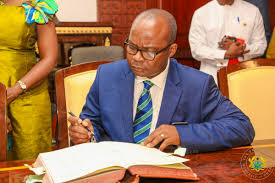
Accra, July 24, 2017//-The Monetary Policy Committee (MPC) of the Bank of Ghana (BoG) has reduced the policy rate for the fourth consecutive time, since November 2016.
The MPC reduced the rate from 22.5 percent to 21 percent, citing a long haul of disinflation process.
Announcing the decision in Accra today, the Governor and Chairman of the MPC, Dr Ernest Addison said the disinflation process would continue to the third quarter of the year.
The policy rate is the rate at which the central bank does overnight lending to the commercial banks in the country.
With the reduction, all the commercial banks are required to reduce their base rates accordingly.
Dr Addison noted: “The disinflation process is still ongoing and this trend is likely to continue all through till the end of the third quarter. Barring any unanticipated shocks, the current stance of monetary policy and expected stability in the exchange rate should ensure price stability.
In the outlook, expectations are for the observed decline in headline inflation to continue and converge towards the medium-term target in 2018”.
Dr Addison added that consumer price inflation has steadily trended downwards since September 2016 partly due to policy tightness, relative stability in the exchange rate and some favourable base drift effects.
“Since the last MPC meeting, headline inflation has declined from 13.0 percent in April 2017 to 12.6 percent in May and subsequently to 12.1 percent in June. In a similar direction, the Bank’s measure of core inflation, which excludes energy and utility price changes from the consumer basket, 2 continued to trend downwards”.
From 13.7 percent in April 2017, core inflation fell to 13.3 percent in May and further to 12.8 percent in June. The results of the latest surveys conducted by the Bank pointed to further decline in inflation expectations.
These trends in headline, core and inflation expectations suggest dampening of underlying inflation pressures. And the pace of disinflation is consistent with the latest forecast results, which show an unchanged inflation forecast horizon since the beginning of the year, he told journalists in Accra.
Inflation, Dr Addison said is therefore expected to continue on its gradual deceleration path towards the medium-term target of 8±2 percent in 2018. Meanwhile the output gap is beginning to close. The recently released GDP data from the Ghana Statistical Service showed that the economy expanded by 6.6 percent on a year-on-year basis in the first quarter of 2017, relative to 4.4 percent in the same period a year earlier.
The stronger growth outcome was largely driven by increased crude oil production. However, the non-oil sector growth was weaker turning in at a modest 3.9 percent in the first quarter of 2017, against 6.3 percent recorded for the same period of last year.
The lower non-oil growth continues to reflect low activity in the services sector. Going forward, the policy initiatives outlined in the 2017 budget are expected to help economic activity pick up and result in much improved growth outcomes.
The Bank’s leading indicator of growth, the Composite Index of Economic Activity (CIEA), suggests some pickup in economic activity in the first five months of 2017, relative to the same period last year.
The observed momentum in the CIEA was mainly driven by exports, construction and credit to the private sector. The latest business and consumer confidence surveys, conducted in June, also broadly reflected positive sentiments in the direction of the economy.
While businesses were optimistic about achieving their expectations on sales and profit, consumer sentiments were largely driven by improvement in household incomes and purchases of durables. Total liquidity measured as broad money supply (M2+) continued to expand on an annual basis driven mainly by the net foreign assets of 3 the banking system.
Broad money supply (M2+) grew by 23.7 percent in May 2017 compared to 16.8 percent a year earlier.
The Committee noted that economic activity continued to improve supported by a rebound in crude oil production, and is expected to remain in line with trends seen in the first half of the year.
The Bank’s CIEA also provides some positive indications of expected increased momentum in economic activity. The broad expectation is that the gradual and steady increases should translate to higher growth profile in the period ahead.
In addition, implementation of fiscal policy measures towards providing stimulus through the key initiatives contained in the 2017 budget statement should provide added impetus to growth.
By Masahudu Ankiilu Kunateh, African Eye Report


